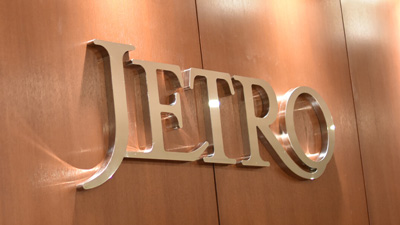UL Japan, Inc.
UL was founded in Chicago, Illinois, USA, in 1894 to conduct objective safety assessment and risk analysis of fire incidents that frequently occurred in the country with the rapid spread of electrical products. The company's mission, "working for a safer world," has reached Japan, and starting with the establishment of a base in Tokyo in 1993, it has now expanded to have seven offices including the headquarters in Mie Prefecture and supports Japanese companies in developing their technologies and products through development of standards and certification tests. We spoke with Masahito Hashizume, VP & Regional GM, CMIT, Asia & MEA of UL, and Masako Matsuoka, Director & GM, CMIT Japan of UL about its business development in Japan.

- Establishment
- 2003
- Destination
- Mie / Kyoto / Aichi / Kanagawa / Tokyo / Chiba
- Service
- Other
-
USA
Update : 2019/09
One-stop service provision
Established in Chicago, Illinois, USA, in 1894, UL is now helping companies bring safe and reliable products to market. The company was established by Wiliam Henry Merill, a founder who had investigated fire incidents caused by electrical system failure and is currently active in more than 20 industries centered on the fire and electrical safety sector. With the remarkable development of technology, its scope of product certification has expanded, and currently more than 22 billion products carry the UL mark, and UL has formulated more than 1,600 standards. The company has now over 14,000 employees worldwide.
UL established a base in Tokyo in 1993 and established its Japanese subsidiary, UL Japan in 2003 (headquartered in Ise City, Mie Prefecture). The company has several bases in areas where manufacturing clusters are concentrated, such as Mie and Aichi Prefectures, and mainly provides services for complying with the laws and regulations of various countries to Japanese companies in rolling out their products overseas. UL Japan also supports foreign companies with product launches in the Japanese market.
UL has offices and test laboratories in more than 40 countries and regions. As in Japan, most of them have testing facilities adapted to each country’s leading industries and technologies. Many Japanese manufacturers have factories overseas. Even if they develop products in Japan and produce them overseas, they can utilize UL’s services through its overseas bases.
Masahito Hashizume, who oversees UL's Asian operations, including Japan, says, “Japanese manufacturers with extensive in-house equipment tend to believe that they should handle operations internally as much as possible. That idea per se makes up their quality assurance operations.” On the other hand, he points out, “such a trend has been over in the last 10 years or so, and fewer manufacturers can complete all the testing in-house.” The increasing variety and complexity of electronic components for manufacturing one product make it challenging to cover quality assurance operations for all the parts in-house. One Japanese parts manufacturer used to deliver more than 70% of its products to domestic manufacturers, but now it ships over 50% to overseas manufacturers. With the increased overseas sales, the number of standards that the company needs to meet has soared, making it impossible to carry out all the quality assurance operations internally.
Therefore, the importance of organizations like UL, which set standards as a third party and provide services to test and certify products, has been increasing. Mr. Hashizume emphasizes, “More and more companies are turning to specialists for quality assurance operations so that they can allocate more resources to other activities that add value to the business.” UL has the facilities and know-how to conduct various tests in the fields of electricity, electronics and fire prevention and provides “reasonably priced one-stop” certification services as well as verification and testing services based on requests from manufacturers. UL Japan has acquired many customers in Japan by pursuing that philosophy.
Working to become a true partner of Japanese companies
Explaining the background of UL’s expansion to the country, Mr, Hashizume says, “We set up business in Japan because we wanted to provide services from near customers in Japan in the Japanese language.”
UL Japan has seven bases: Mie (headquarters), Kyoto, Aichi, Kanagawa, Tokyo and Chiba Prefectures. It is important to be physically close to the customers to carry out the measurement, verification, and certification operations by following their needs. In fact, the automotive-related facility, ATC (Automotive Technology Center), opened in 2017, and the reliability testing laboratory opened in 2019 in Aichi and Mie Prefecture, respectively, home to automobile and related parts manufacturers clusters.

UL Japan Ise Headquarters
Mr. Hashizume says, “It's vital for us to align ourselves with the direction of Japanese industry and technology development and to be a true partner of customers. Although we are a foreign-affiliated company, we have a strong desire to revitalize the Japanese industry together with Japanese manufacturers and the government. There is a complementary relationship between the client companies and UL Japan, whereby “Our customers focus on developing new products. UL Japan helps them achieve quality assurance.”
For UL Japan to provide services that meet the customer needs, it is essential to share information with the government and standards-related organizations. The government’s goals and the accompanying changes in laws and standards significantly affect testing methods. It is necessary to anticipate changes in the circumstances to respond to customer requests make appropriate investments in facilities at the right timing. In addition, the company needs to respond to development of emerging technologies such as wireless technology used for automobiles and energy harvesting. UL Japan participates in committees and subcommittees that verify and certify new technologies and actively engages in a wide range of discussions on the establishment of evaluation methods and the development of standards. Mr. Hashizume believes that participation in such activities is essential for receiving requests for certification work and building credibility among customers.
By quickly acquiring information and grasping trends related to the government, standards-related organizations and companies, UL Japan can provide services that support new technologies and new standards in a timely manner.
Testing as a product sales strategy
UL has traditionally been providing verification and certification services based on existing international standards, UL standards, and the standards established by the manufacturer to which UL’s customers deliver. Mr. Hashizume says that recently requests from companies that aim to conduct tests for marketing purposes are increasing. There is a growing need to discuss effective tests and evaluations for promoting added value and customizing them with UL.
As a culmination of these verification services, UL issues the UL Verified Mark. It is a persuasive means of promoting a product because UL, a third party, has evaluated the features that the company wants to emphasize when bringing the product to market. UL works with customers to develop a test plan and verification method to determine which test can be effective in promoting the product’s specific functions and provides certifications and verifications. The customer can emphasize the product’s performance by describing verified results or standard in the product press releases, catalogs or instruction manuals.
One of the strengths of the Japanese market is the automotive industry
Describing the strength of the Japanese market, Mr. Hashizume says, “The automotive industry is one of the industries where Japan is currently strong. If you look at UL globally, in terms of the automotive field, UL Japan is at the top and is running the largest business.”
Within the automotive industry, one of Japan’s leading fields is autonomous driving technology. Laser technology for illuminating images around the vehicle, called LiDAR, is very important for autonomous driving, and Japan is leading in this field with proprietary technology. UL is also actively working to provide services in this area.
Mr. Hashizume says, “There are always industries where Japan has strengths, and they are constantly changing and evolving. The strategy of manufacturers is to develop high value-added technologies and quickly bring them to market. So, I think that new technologies will continue to come out in Japan. We consider that measurement, verification and certification of these new technologies are a part of the development process in a broad sense. When customers develop a product and bring it to market quickly, they may face a variety of challenges, and we want to continue to help them solve those issues.”
In this way, when there are world-leading technologies in Japan, UL Japan sometimes gives input to the UL headquarters. As an example, an electronic cigarette standard, UL 8139, was formulated based on suggestions from Japan. In 2018, UL Japan established the EHV Chamber (an anechoic chamber with a fixed dynamometer for EV/HV equipment) in the ATC in Aichi Prefecture, the first of its kind within the UL Group. Currently, UL Japan is the only UL base to have such a facility throughout the world. The investment was only made possible because of the high domestic demand for UL Japan.
Attracting talented human resources is the challenge
For UL Japan, which employs about 600 people, acquiring talented human resources is essential at its bases in Mie and Aichi Prefectures.
Japan has unique laws such as the Electrical Appliance and Materials Safety Act and the Radio Law. The technical standards specified in these laws are often JIS standards, based on international standards but tailored to Japan’s particular circumstances. For example, IEC 62368-1, a standard for ITE/AV products relevant to many Japanese companies, had to be converted into a Japanese standard called JIS C 62368-1. UL Japan actively participated in the committee that is responsible for this process and contributed to its creation. This process was not simply a matter of English to Japanese translation; rather, it needed experts with a deep understanding of the technology who could consider what wordings would be best to specify the requirements. While UL Japan recruits many talents from the science field who are skilled in specialized technologies, Mr. Hashizume says that acquiring high-quality personnel who can handle new subjects such as software is a challenge to grow business in Japan.
In the US, there is an academic field called human factors engineering (HFE). It aims to prevent human error by conducting behavioral analysis to avoid machine malfunction caused in situations such as when a person loses control with panic. HFE is a technology applicable not only to the operation of medical devices but also to autonomous driving, and its significance has increased with the development of autonomous driving technology. However, since there are only a few universities in Japan where one can learn HFE, UL Japan hires Japanese and foreign staff who have studied abroad to offer verification services in this field in Japan.
Focusing on services to the mobility industry for “CASE”
In recent years, UL Japan has been focusing on expanding test facilities to support the Japanese mobility industry for "CASE (connected, autonomous driving, sharing, and electrification)."
In January 2020, the company established a new EMC laboratory with two EHV Chambers in Kashima EMC site in Chiba Prefecture. In addition, in September 2020, UL expanded its reliability testing laboratory at the headquarters in Mie Prefecture in order to further enhance services for in-vehicle devices and respond to increasing demand for reliability testing for mobility components. In addition, the headquarters in Mie Prefecture opened a Large Mobility Laboratory in July 2020 to handle EMC testing for large-scale of construction machinery and other equipment, and, in April 2021, the company introduced testing facilities for mid-size battery, which are increasingly used in applications such as personal mobility.
UL Japan will continue to provide total compliance solutions for EMC, radio, cyber security, interconnectivity, materials, batteries, etc., and will expand the potential of "mobility" originating from Japan to Japanese society and the world.

Masahito Hashizume, VP & Regional GM, CMIT, Asia & MEA of UL

Masako Matsuoka, Director & GM, CMIT Japan of UL
(Updated in September 2019 and April 2022)
Company history
- 2003
-
Establishment of UL Apex through merger of UL Japan and A-PEX International
- 2007
-
Name changed to UL Japan
- 2017
-
Establishment of ATC Laboratory for the automotive industry in Miyoshi, Aichi
- 2019
-
Establishment of reliability testing laboratory for vehicle equipment in Mie Prefecture Headquarters
- 2020
-
Establishment of a next-generation mobility building with two EHV Chambers at the Kashima EMC Laboratory in Chiba Prefecture.
Opened a large-scale mobility test building at the headquarters in Mie Prefecture, which handles EMC testing of construction machinery and other large-scale equipment.
- 2021
-
Introduced a mid-size battery facility for personal mobility and other applications at the headquarters in Mie Prefecture.
UL Japan, Inc.
- Establishment
-
2003
- Business overview
-
Safety authentication and technical standard creation for electronic and electrical products
- Parent Company
-
UL LLC (America)
- Address
-
4383-326 Asama-cho, Ise City, Mie 516-0021
- URL
Support from JETRO
- Information (on real estate)
- Referrals to local government officials
- Assistance with public relations (inviting the company to speak at business seminar and PR support)
- Invitation to participate in a JETRO event
Related Industry
Regional Information
Explore More
-

Success Stories
Success Stories are based on interviews conducted with foreign companies and foreign-affiliated companies that have successfully come into the Japanese market.
-

JETRO’s Support
We provide consistent one-stop service for establishing a base or expanding business in Japan.
-

Setting up Business
You can find information on overall and detailed steps, cost estimation, an overview of the laws, regulations and procedures related to setting up business, and more.
Contact Us
Investing in and collaborating with Japan
We will do our very best to support your business expansion into and within Japan as well as business collaboration with Japanese companies. Please feel free to contact us via the form below for any inquiries.
Inquiry FormJETRO Worldwide
Our network covers over 50 countries worldwide. You can contact us at one of our local offices near you for consultation.
Worldwide Offices




























